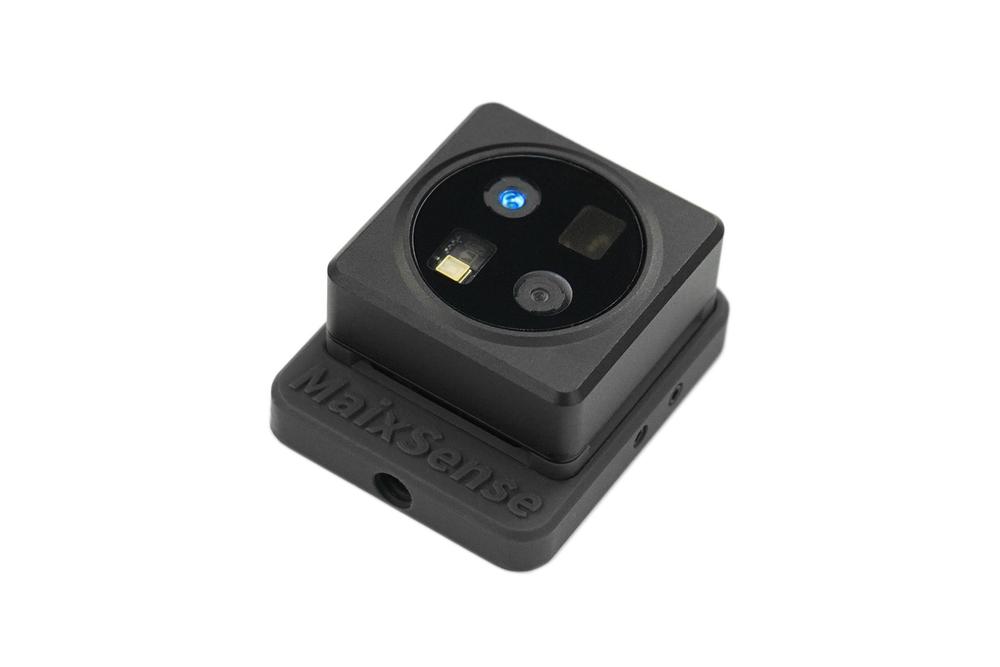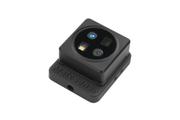DFRobot RGB-D 3D ToF Sensor Camera (Supports ROS1 and ROS2)

Description Attachments
The RGB-D camera is a state-of-the-art 3D time-of-flight camera module that integrates RGB capabilities with a resolution of 320×240, combined with an inertial measurement unit (IMU). This enables it to capture all RGB-D data seamlessly through a simple USB connection. Complemented by a web-based interface, users can effortlessly preview depth maps, point cloud data, and enjoy real-time colorful 3D rendering.
Linux users will appreciate its immediate compatibility, with no additional drivers needed, and its support for both ROS1 and ROS2 frameworks. This makes it ideal for developing open integration packages and leveraging sample codes. Moreover, the included Python SDK allows for the development of sophisticated applications like 3D facial recognition, robotic arm operation for grasping, and efficient SLAM mapping using detailed point cloud data.
Designed with the Internet of Things (IoT) in mind, this integrated 3D Time-of-Flight (ToF) solution is both cost-effective and user-friendly. With a suite of algorithms, the camera can measure distances, detect multi-zone body positioning, and support posture detection and positioning. Essential calibration functionalities further expand its applications to include fields such as smart home automation, innovative lighting solutions, smart parking systems, and smart projectors.
Employing the reliable Time-of-Flight technology, the RGB-D camera uses light, ultrasonic waves, or microwaves to accurately determine distances between the camera and objects. Through the combination of RGB and depth sensors, it simultaneously captures color and depth information. This dual capability is essential for applications requiring depth mapping and visualization, where distance variations are displayed as different color tones, highlighting the shift in distance with cooler and warmer shades for easy interpretation.
Properties
Delivered in 5 to 10 days
Customer questions
Customer Reviews
- In stock DFRobot DFPlayer - A Mini MP3 Player For Arduino € 7,50 View product
- In stock DFRobot Gravity: MOSFET Power Controller € 5,- View product
- In stock DFRobot DF9GMS 360 Degree Micro Servo (1.6Kg) € 5,- View product
- In stock DFRobot Gravity: 8-Digital LED Segment Display Module (Green) € 7,50 View product
- In stock DFRobot Gravity: 8-Digital LED Segment Display Module (Red) € 7,50 View product
- In stock DFRobot Gravity: Analog Turbidity Sensor For Arduino € 12,25 View product
- In stock DFRobot Gravity Photoelectric Water / Liquid Level Sensor For Arduino € 8,75 View product
- In stock DFRobot DFRduino UNO R3 - Arduino Compatible € 16,- View product
- In stock DFRobot Gravity: Waterproof DS18B20 Sensor Kit € 9,40 View product
- In stock DFRobot 8x8 Matrix ToF 3D Distance Sensor (I2C&UART, 3.5m Range, 60° FOV) € 27,25 View product
- In stock DFRobot DFRduino Mega2560 (Arduino Mega 2560 R3 Compatible) € 28,50 View product
- In stock DFRobot Fermion: DFPlayer Pro - A mini MP3 Player with On-board 128MB Storage (Breakout) € 11,- View product
- In stock DFRobot FireBeetle ESP8266 IoT Microcontroller (Supports Wi-Fi) € 9,25 View product
- In stock DFRobot Gravity: Digital 360° Tilt Sensor for Arduino € 3,60 View product
- Reduced In stock -65 % DFRobot Gravity: Gesture & Touch Sensor € 13,95 € 4,85 View product
Recently viewed items
- DFRobot RGB-D 3D ToF Sensor Camera (Supports ROS1 and ROS2) € 134,50 View product
- DFRobot Fermion: 2.0" 320x240 IPS TFT LCD Display with MicroSD Card (Breakout) € 22,25 View product
- DFRobot Pressure Sensor Strip (400mm, 20g-10kg) € 13,50 View product
- DFRobot RDK X5 Stereo AI Vision Camera Module (178° FOV, Dual 2MP) € 49,50 View product
- DFRobot Raspberry Pi 4 Metal Case with 3.5" 480x320 TFT Touch Screen € 37,- View product
- New Waveshare QFN-56BT-0.5-01, Test & Burn-in Socket € 147,40 View product
- New Waveshare QFN-24BT-0.5-01, Test & Burn-in Socket € 185,75 View product
- New Waveshare IC51-0524-411-1, Test & Burn-in Socket € 88,- View product
- New Waveshare QFN-32(40)BT-0.5-02, Test & Burn-in Socket € 118,75 View product
- New Waveshare QFN-16BT-0.65-01, Test & Burn-in Socket € 110,25 View product
- New Waveshare OTS-24(28)-1.27-04, Test & Burn-in Socket € 43,50 View product
- New Waveshare QFN-28(36)B-0.5-02, Test & Burn-in Socket € 153,75 View product
- New Waveshare USB 3.2 Gen1 TO Gigabit Ethernet Converter, Driver-Free € 18,75 View product










